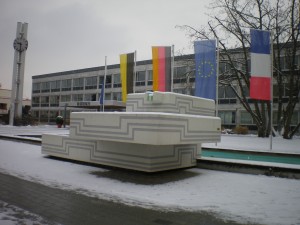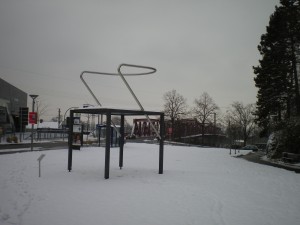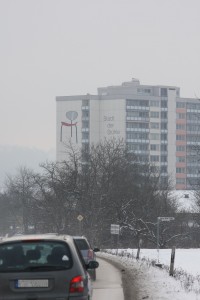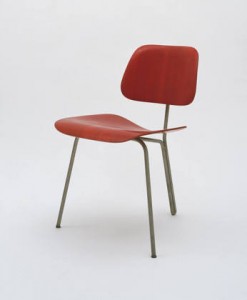
When we were still young, fit and healthy, towns and cities existed.
Just existed.
These days in order to exist a city needs to be the city of something. And so as one drives along a German motorway, every ten metres or so comes a large brown sign announcing the next conurbation as "Chemnitz - City of the Modernity", "Pied Piper City Hameln" or "Prien am Chiemsee - City of the criminally lazy taxi drivers".
Not wanting to be the outsider in this age of claims making, Weil am Rhein has decided to call itself "Weil am Rhein - City of Chairs"
And what could be more appropriate for a city that uses an image of the Vitra Design Museum to illustrate the "Economy and Tourism" section of their homepage and which welcomes 100,000 tourists a year to the Vitra Campus in the Charles Eames Strasse.
And it's certainly a lot catchier than "Weil am Rhein - City of the huge goods train station"
There's just two things that bother us.
Trifling, small, things, but you know us....

In front of the modernistic and inspirational "Rheincenter" stands a huge statue of a chair.
A chair that isn't, wasn't and never will be produced by Vitra. Rather by Dutch producer USM Pastoe.(Obviously not to confused with Swiss producer USM Haller)
Apple Honey by Shiro Kuramata is a wonderful chair.
Shiro Kuramata did partake in the very first Vitra Editions, alongside the likes of Frank Gehry and Ron Arad.
Vitra even produced Shiro Kuramata's equally delightful "How High The Moon" chair.
But not Apple Honey.
Much more confusing is the image painted onto the side of one of the four tower blocks that "tower" over the Vitra Campus and the new VitraHaus.
Next to the text "City of Chairs" is a picture of a chair.
A most curious, three leggeed, chair.

Our initial reaction was that it was a DCM by Charles and Ray Eames. And very fitting we found that too given the close ties between the the Eames', Vitra and Weil am Rhein.
Except the DCM is of course a four legged chair.
And try as we might we simply cannot think of a single three legged chair that Vitra produce.
Our next guess was that it was an "Ant Chair" by Arne Jacobsen...also an excellent representative of 20th century chair design. But in the Ant Chair the seat and the back are formed from one piece of wood. And the single leg is at the front.
Then we really thought we had it: SE 69 by Egon Eiermann. But no the SE 69 also has the single leg at the front.
Egon Eiermann's SE 42 does have the single leg at the back, but is made of wood.
Indeed the longer we stood in the middle of Römerstrasse, holding up the traffic and irritating the good folks of Weil am Rhein, the more we struggled to think of a three-legged chair which has a steel tube single back leg.
Principally on account of the instability factor.
Only once we were back in Leipzig could we track it down, thanks to the MoMA New York archive.

Three-Legged Side Chair by Charles Eames for the Evans Products Co from 1944.
A chair which may or not have been taken on by Hermann Miller when they acquired the Eames rights from Evans in 1946. And so which may or may not be part of those Charles and Ray Eames products to which Vitra the European production rights posses.
Which is a long way of saying, Weil am Rhein appears to celebrate it's "City of Chairs" status with two chairs which have nothing to do with it's status as one of the most important centres of contemporary European designer furniture production.
Visitors to the new VitraHaus can ponder this paradox from the fourth floor window.
Or simply enjoy the wonderful view over the Vitra Design Museum and the orchard meadow.